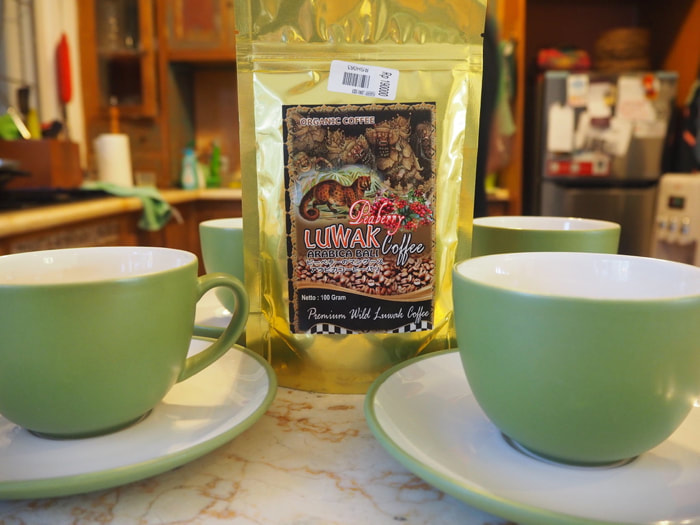|
Perhaps like you, I first heard about kopi luwak in the film The Bucket List. In fact, I first heard of bucket lists in the The Bucket List (a film which never quite matched its cultural influence with its box office earnings). Jack Nicholson’s curmudgeonly character explains that kopi luwak is the world’s most expensive coffee, with beans gathered from the excrement of a civet – a type of wild cat - found in Indonesia. The beans are collected, cleaned, packaged, and sold for up to $70 per 100g. Yes, this is a thing. In fact, kopi luwak is one of the first things I sought out after arriving in Bali, where “Wild” and “Organic” kopi luwak sells for about $15-20 per 100g. In the throes of high tourist season, I quickly learned that the Balinese are experts in the Art of Separating Tourists from Money, especially the taxi drivers, who are the worst shysters I’ve encountered anywhere. Balinese cunning might explain why stories abound of poor civets being kept in battery cages and force fed coffee berries like geese on their transition to fois gras. Today’s civet suffers greatly in order to meet both tourist and international demand for the bounty of their bowel movements. The story also goes that the Asian palm civet carefully chooses only the finest coffee berries to eat, the epitome of natural selection. After consumption, the berries receive some rare biological gift in the civet’s digestive tract, are pooped-out whole, and are scooped up, processed and marketed as the world’s finest and expensive coffee. Having procured 100 grams of Organic (says the bag) and Wild (why would they lie?) luwak from a souvenir shop, I reviewed several sites as to the best method to prepare the coffee. We used the French Press we’ve been carrying around the world with us, and prepared the press with the same care the wild civet must have taken when it squeezed the beans out its anus. Gently raising the cup to my nose, it smelled exactly like… coffee. Putting my lips to the black elixir, it tasted exactly like…Angels Singing with Harps in Heaven. Nah, just kidding, it tasted like coffee. Actually, it tasted worse than our regular coffee. A little too thin, a little too complex, and a little too obvious that the only remarkable thing about this coffee is the words written on the package in which it came. Plus, I felt terrible drinking my cup of Joe. I couldn’t help but picture an abused cat trapped in a battery cage, force-fed coffee berries by steely-eyed, clove-smoking men with big sticks. Despite the reassurances of “Wild” and “Organic” providence on the vacuum-sealed baggie, the amount of times I’ve been ripped off in Bali made me question the veracity of the packaging. Taxi drivers doubling the agreed upon rate; meals suddenly costing more; paying to park; paying to relax on the sand; paying to use a floatie by the pool; paying extra; paying more; paying “special price for you.” Can’t really blame these folks, given that tourism accounts for 80% of the island’s economy, bringing in 3.5m people a year, with the Chinese – those bastions of cultural sensitivity – leading the charge, and Australians drunk on the island’s cheap beer and anarchy not far behind. Prized for its unique rarity, when a peak experience jumps the shark, there’s nothing unique or rare about it any more. Rather, it quickly becomes the domain of the unscrupulous cashing in on a phenomenon. This is the case with the luwak or the kecak dance in Bali, and it is the case worldwide (see: every tourist trap you’ve ever been to). Meanwhile, those poor civets in Indonesia must deeply regret the bloke who first discovered that coffee beans extracted from their faeces taste delicious. They probably wonder why the guy didn’t just eat the coffee beans, crap them out himself, and give that a taste. Perhaps the human digestive tract would have added an extra layer of smoothness too. It certainly would add a layer of complexity to impress the coffee connoisseurs, the same ones that have rated kopi luwak poorly in several blind tastings. It is my opinion, therefore, to leave the poor civets alone, and release kopi luwak from its dubious claim to be the world’s best cup of coffee. Let the cats live in peace, and let's ignore the bright red coffee berries shining within their scat. A steaming cup of kopi luwak is certainly a unique culinary experience, although is probably better described as a steaming pile of something else.
0 Comments
|
Greetings.
Please come in. Mahalo for removing your shoes. After many years running a behemoth of a blog called Modern Gonzo, I've decided to a: publish a book or eight, and b: make my stories more digestible, relevant, and deserving of your battered attention. Here you will find some of my adventures to over 100 countries, travel tips and advice, rantings, ravings, commentary, observations and ongoing adventures. Previously...
July 2024
Categories
All
|


 RSS Feed
RSS Feed

